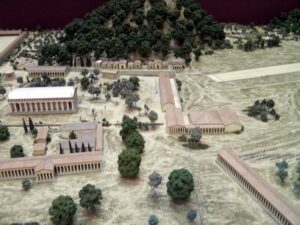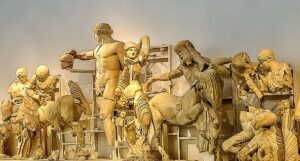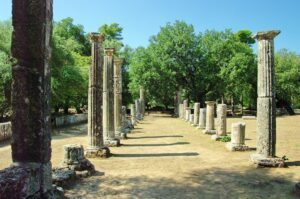
Editor’s Note: The Olympics is considered the world’s most famous and important sports competition. More than 200 teams representing countries throughout the world participate, entering their finest athletes. The event was first inspired by the ancient Olympic Games, held in Olympia, Greece from the 8th century BC to the 4th century AD. What follows is an interview with Dr. Paul Cartledge by interviewer Richard Marranca about the origins, some of the individual events, and the archaeology of the famous games….
Richard Marranca (RM): Could you give us an overview of the Olympics? Did it have religious origins? Was a truce in effect during the Olympics? Where and when did it begin? And at what time in history did it emerge?
Paul Cartledge (PC): The ancient Olympics were traditionally founded in what we call 776 BC or BCE. They were a quadrennial (held every four years) religious festival dedicated to the worship of Zeus of Mt Olympus, open at first to all Greeks but only to Greeks. I emphasise ‘Greeks’ (or as they called themselves, Hellenes), since the Olympics was one of the – very few – ‘panhellenic’ festivals: until the Romans started conquering Greece in the 2nd century BCE, and began demanding to be allowed to compete, the Olympics were open only to Greeks. Mainly male Greeks competed, though women of a certain profession who were also Greeks would have been present to provide ‘comfort’ services to athletes and spectators alike. Religious worship at the site has been documented archaeologically for several centuries before the 8th century BCE (700s). But not before the 8th century could anything like a supra-local festival have been imagined or implemented. That was the era when Greeks both within old Greece (the Aegean world) and in the diaspora world began to be in regular contact with each other. Greeks had then started settling permanently both in the West – south Italy, Sicily, south of France, east coast of Spain, north African coast – and in the East and north-East around the Black Sea. Probably quite small-scale and mainly Peloponnesian to begin with, the Olympic festival had become a truly international affair by the beginning of the 6th century, when the Olympics became locked into a 4-event cycle, the premier athletic circuit of the ancient Greek world. The Olympic ‘truce’ is a separate and very special subject. The ancient Greek term for it meant literally armistice – a holding back of hands. It came into force before and after the 5-day Games – not, as often thought, because the Games were in an important sense sacred, but because Greek cities were often at war with each other, and the summer months were the active campaigning season. So, the truce – reinforced by sanctions of impiety against would-be transgressors – was a practical necessity: to enable competitors and spectators to get to and back home from Olympia in safety and security.
RM: What about archaeology over the last centuries or at present in Olympia?
PC: The site of ancient Olympia, which had been submerged beneath layers of mud in the centuries after the ancient Games were shut down by a Christian Roman emperor in c. 400, was rediscovered in the 1760s by a British antiquarian. Six decades or so later, a French-led expedition showed signs of interest in excavating it, but it was not until 1875 that serious archaeology on the site was first undertaken – with the full permission of the Greek government – by the German Archaeological Institute. Their controlled excavations have continued to the present day, interrupted only by two World Wars. It was these German excavations which gave strong encouragement to a French aristocrat, Pierre Baron de Coubertin, to conceive of the idea of staging or re-staging a ‘modern’ Olympics – an idea first realized in 1896, though not at Olympia but in Athens. German excavators have been responsible for a stunning series of publications as well as for unearthing the vast majority of the objects to be found in Olympia’s two museums (one specifically dedicated to the history of the site and Games, both Ancient and Modern). A recent publication – Olympia (2021) by the British-based American archaeologist Judith Barringer – heroically attempts to provide a chronologically ordered account of the site and the finds. There are numerous other accounts of the Games, often very well illustrated. The site is of course owned by the Greek state, but the German Institute dig house and the ever-presence of German scholars give the site a distinctly teutonic feel. But even the best laid plans cannot be totally, 100 percent proof against the ravages of both nature (earthquakes) or man (theft) or a combination of both (wild fires).
RM: Is it true that in the early Olympics, athletes were naked? Why?
PC: Yes, and not only in the ‘early’ iterations of Games, which traditionally by modern reckoning originated in 776 BCE, with just the one ‘event’, a roughly 200-meter dash. For (naked) men only. In the 5th century BCE the managers of the Games (below) doubled down on nudity, when the mother of a competitor, from a famous athletic family of Rhodes (below), sought to gain entry to a men-only space by dressing as a man but fell over and revealed the anatomical female truth. Thereafter trainers too and not just competitors were required to disrobe completely in the most sacred area. (Just one woman at any one time was ever permitted into the otherwise men-only space: a local priestess of Demeter.)
As the Games were held around the time of the second full moon after the summer solstice, there was no danger of anyone dying of cold (peak temperatures would normally have reached the high 30s C or low 40s). But why nudity? A question often asked and usually answered rather lamely by saying that, as the Games were a form of worship of Zeus of Mt Olympus, the nudity must have some ‘ritual’ significance, possibly to do with fertility. However, it’s worth adding that the ancient Greek word for totally naked was (masculine form) gumnos – from which came the ancient Greek word for the carefully demarcated space where athletes competed (boxing, wrestling) in fun or deadly seriousness, namely gumnasion, whence the English word ‘gymnasium’. Strict rules were observed regarding eligibility for exercising in a gumnasion: male citizens only were allowed, subadult boys had to be accompanied/watched over by a slave attendant, and trainers and supervisors of a gymnasium were forbidden to indulge in homosexual courting let alone full-on action.
RM: What were some of the earliest events? Could some of them be dangerous?
PC: By the early 5th century BCE (470s on) the Games athletics program had settled down to nine events, most divided by age category between Men (18 plus) and Boys (roughly 14-18): the stade (200-meter dash, 776-), diaulos (roughly 400 meters, 724), dolichos (‘long’ race, 24 laps of the Olympic stadium, up and down 12 times, roughly 5000 meters), pentathlon ‘5 contests’ (200-meter dash, javelin-throwing, discus-throwing, long jump, and wrestling, 708), boxing (bare-knuckle, 688), 4-horse chariot-race (staged in a separate, specially built stadium, the Hippodrome or ‘Horse-Race Course’, 680), pankration or ‘all-strength contest’ (a combination of wrestling and judo, biting and gouging forbidden, otherwise no-holds-barred, 648), horse-race (648), race in armor, roughly 400 metres (520), mule-cart race (500-448), calpê (race involving dismounting and remounting horses, 496-448), and sunoris (2-horse race, 408). Dangerous? The thrills and spills of horse-racing and especially chariot-racing are well known from movie re-creations such as that in Ben Hur. But the seriously dangerous, i.e. life-threatening, events were those sometimes lumped together as the ‘heavy’ events: boxing, wrestling, and above all the pankration.
RM: Can you give a brief portrait of Olympia in terms of what it looked like, what went on there, the spectators and so on?
PC: The site of Olympia in the northwest Peloponnese of southern Greece was chosen not least for the availability of a reliable water-supply, even at the height of summer. It was not a single space but three spaces: most sacred was the Altis, a grove at the heart of the site within which the athletics events were staged, and where the temples of the chief divinities being worshipped, Zeus and his sister-wife Hera, were built. Besides those two temples (one of which, the Zeus temple, housed a statue destined to be accounted one of the 7 ‘Wonders’ of the ancient world) the single most important religious structure was a huge and ever-growing ash-altar, composed of the remains from sacrificing – ritually slaughtering and then roasting – bulls in honor of Zeus. Outside the Altis but integral to the Games was the Hippodrome (above). Then there were all those spaces and structures open for religious worship all year round, when the Games were not being held. We don’t know how many competitors there were present at any one Game – several hundreds probably. But they were massively outnumbered by the spectators, who were also pilgrims, and of course they needed food and shelter. The noise, the smell, the er mess – it doesn’t bear thinking about too closely, if there really were on the order of 40,000 of them gathered at Olympia every four years, the largest single gathering of Greeks anywhere at any time.
___________________________

Above and below: Plan of the Sanctuary of Olympia. Bibi Saint-Pol, Public Domain, Wikimedia Commons.
Legend:
|
|
___________________________

Model of Olympia, as exhibited at the British Museum. Carole, CC BY-SA 4.0, Wikimedia Commons
___________________________
RM: How did athletes prepare in terms of diet, exercise, coaching, travel, rituals, and so on?
PC: Late sources such as Philostratus (2nd c. AD) go into the details of athletes’ training regimes and diets. Meat and fish, both expensive, were recommended by some, while others favored figs, moist cheese and wheat. Specialist coaches there certainly were, such as Pythagoras (not the philosopher-mathematician). One essential feature of the ancient Olympics was the absolutely obligatory period of pre-Games training, actually at Olympia, during which the judges inspected the would-be competitors and decided on the eventual list of those who would actually do the business in and around the stadium in the Altis. Part of these preparatory training exercises took place in the Palaestra, literally the wrestling arena. Travel to Olympia – at first by boat if coming from, say, France, Spain or the Black Sea – would be mainly on foot, possibly by mule or donkey. Equestrian competitors of course had to get their horses and teams laboriously to Olympia. Sportsmen tend to be superstitious, so one can imagine that in the run-up to a Games there would be a lot of attendance at shrines of gods, goddesses, heroes and heroines, much offering up of prayers and animal or vegetable sacrifices, and plentiful making of vows, in general promising that in return for supernatural assistance the athlete or equestrian competitor would shower the appropriate supernatural power with return gifts in the event of success.
_____________________________

The “Exedra”: stone seats reserved for the judges at the games. NeilEvans at English Wikipedia, Public domain, Wikimedia Commons
_____________________________
RM: Were there other games too? In which games were women allowed to compete? Were Spartan women especially successful in sports?
PC: From the 570s BCE the Olympics had been enfolded in what the Greeks called a ‘Circuit’ (periodos) of ‘crown’ (symbolic prizes only) games, as its numero uno. The other three were the – also quadrennial – Pythian Games held at Delphi in central Greece (in honor of Apollo), and the biennial Isthmian Games (held at the Isthmus in honor of Poseidon) and Nemean Games (at Nemea in north-east Peloponnese in honor of Zeus). ‘Crown’ games were so called because the (first-only) prizes on offer were crowns made from natural produce – olive or bay leaves, or wild celery. Most Greek games, however, were not ‘crown’ games but value-prize games: the material prizes awarded were worth something, such as the amphorae filled with sacred olive oil on offer at Athens’s quadrennial Panathenaic Games, or the large bronze vessel that winners at the Heraea (games in honor of Hera) took home from Argos. Young girls and young women, it comes as something of a surprise to learn, did compete in public, though not stark naked, at Olympia, in a race in honor of Zeus’s sister-wife Hera. But not at the same festival as the men, and in only one running race, a shortened stade (about 160 meters as opposed to the men’s 192.24). One can well imagine Spartan females taking part in such a race, though we don’t happen to know whether any ever did, and it’s possible that Spartan women’s bulkier-than-normal physique (due to a superior diet) was not best suited to track events. On the other hand, the first woman in all Greece to win an Olympic victory was indeed a Spartan, though she was no ordinary woman but a princess royal, Cynisca. She won first in 396 and then again in 392, with the same team of mares in the four-horse chariot-race (tethrippos).
RM: What are some differences between the Paris Olympics 2024 and the ancient Olympics? Yes, that would take a book, but if you can say a few things. And what inventions from the 1936 “Nazi” Olympics are still part of today’s Olympics?
PC: Where to start….!
i. The ancient Games, despite their religious framework (more below), were a kind of paramilitary exercise, ‘War minus the shooting’, as George Orwell called international professional football (soccer) matches, which are euphemistically called ‘friendlies’ today. Competitors competed as individuals – but the (literal) song and dance that the cities of winners indulged in, and the material and symbolic super benefits they conferred on their triumphant citizens, demonstrate that Olympic competition was seen by them as being significantly the continuation of war by other means. In 364 BCE sacrilegiously warfare actually broke out within the Altis itself.
ii. The ancient Olympic ‘truce’ is regularly misunderstood, not least by de Coubertin. Its original name is a giveaway: literally an armistice (ekekheiria). It was introduced and had to be introduced as a way to enable competitors and pilgrims to get to and from the Games unharmed, even if their states happened to be at war with each other, often enough the case. The truce in other words was not in itself an expression of a pacific or pacifist ideal.
iii. Gentleman amateur? An American scholar in 1984 exploded the ‘amateur’ notion. By no means all competitive conduct was gentlemanly (see iv). And of course de Coubertin’s Victorian prudishness ruled out male nudity. On the other hand, in his ‘gender-critical’ stance de Coubertin was on the money. There were women’s athletics in ancient Greece, including at Olympia (above), but … not at the same time or on the same scale as the (men-only) Olympics.
iv. Fair Play? Were the ancient Olympics ‘sport’?? What I’m getting at here is twofold: first, the use in English of the adjective ‘sporting’: sporting behavior is behavior that not only falls within a strict and narrow interpretation of the rules but also interprets those laws generously, and especially in relation to one’s own opponent, in such a way as to minimize one’s own advantage. Not many if any instances of such ‘sporting’ behavior are on offer from the ancient Olympics. Rather the reverse, for, as two Canadian scholars have written, ‘The ancient Greek rule books seem to have passed over many tactics we would consider the worst sort of dirty fighting’. Consider only the ancient equivalent of today’s terrifying MMA (Mixed Martial Arts), that is the pankration. No gouging of eyes, no biting – those were the rules. But a famous 5th-century Athenian drinking cup shows precisely both of those illegal moves in graphic action.
v. Next, I move on to the spirit of contest: you might think that contest or competition was something universally human – not so! Our English word ‘agony’, meaning extreme pain, is derived from the ancient Greek noun agônia, which meant competitiveness, in its specifically Hellenic form – zero-sum, winner takes all; in the ancient Olympics there was just one ‘prize’, a symbolic olive wreath, no silver let alone bronze medals – both of which were part of de Coubertin’s soppy idea that taking part in the Games was as important if not more important than winning.
vi. Religion: from agonia I move penultimately to Agôn, capital A. The ancient Greeks did not only practice an extreme form of ultra-competitiveness but they also, literally, worshipped, paid cult to, a personified ‘Agon’. He (the Greek noun is masculine) had a statue at Olympia mentioned in the 2nd c. CE by Pausanias (5.20.3, 26.3), and he was related, not surprisingly, to two other abstractions of personifications, Zelos (Emulation) and Nike (Victory). But most important of all is that this particular form of competition was especially associated with religious festivals, so that any religious festival involving competition and prize-giving could be labelled an agôn. This is yet another reminder that the ancient Olympics were staged within an essentially religious framework, a henotheistic, polytheistic framework deeply alien to our ways of thinking and doing.
Finally, to ram the point of difference home, I bring to you a
vii. Legacy that is no legacy: the Marathon
The universally popular marathon race of today was first invented, introduced and run in and around Athens in the first Modern Olympics of 1896, ‘after an idea’ (as they say in the movies) by French classicist Michel Bréal, proposed and accepted at the 1894 congress. At first, of course, it was men-only. Indeed, not just at first: there was no women’s Olympics marathon race until 1984 (L.A.). Since then, a mere marathon is considered relatively tame and everyday – a question of breaking the 2-hour time barrier, an entirely modern notion. The real agonists of our day go in for ultra-marathons, runners such as my good friend Greek-American Dean Karnazes, who’s acquired the nickname ‘Mr Ultramarathon Man’. He’s run ultramarathons all over the world, including the Spartathlon, which was first staged in 1982 and has a far better ancient pedigree (Herodotus…) than the marathon. Why ‘marathon’, anyway? It took its name and length (some 40 km) from its route, from Marathon on the east coast of Atttiki to central Athens, and its inspiration/legitimation from an alleged original run in 490 BCE, following the Battle of Marathon – though even the ancient Greeks themselves couldn’t agree on the name of that runner. However, and this is my final, clinching point: at the original Olympics the ‘long’ race, the dolichos, was a mere 24 laps of the roughly 200-meter course or, in our terms, something like a 5000 meters or middle-distance event. No ‘marathons’ for the ancient Greeks, thank you very much.
Finally, an invention of the Hitler Games of 1936 that has stood the test of time? The torch-relay. The Olympic flame was an invention of 1928. It was in keeping with de Coubertin’s Olympic ideal that it should be lit at Olympia and then transported to the – movable – site of each modern Olympiad.
RM: Did Alexander the Great like sports? Did his father enter horse races at Olympia? Any word about Plato or other philosophers enjoying the Olympics? Did or could any of the Ptolemies, including Cleopatra VII, sponsor any events or horse racing participants?
PC: Philosophers tended to be sniffy about athletics and athletes – far too preoccupied with their bodies (bulking up, etc), and not nearly interested enough in the things of the mind. King Philip II of Macedon, father of Alexander III (the Great), won a horse race at Olympia in 356, the year of Alexander’s birth. Alexander is credited (or debited) with saying that he would compete at Olympia – but only if all his fellow-contestants were also kings. That was probably a cop-out: he would not have been interested in taking part in any contest he might not win. A homonymous ancestor, King Alexander I, had taken part in the Olympics – but for him it really was the taking part and not the winning that mattered, since being allowed to compete proved his (challenged) status as a true-blue Hellene. So far as we know, no Ptolemy competed in person in any Olympic event, partly because Ptolemy II founded in 279 BC games named after his family, the Ptolemaia, and celebrated at Alexandria, which were an Olympics equivalent for Egyptian Greeks. But several of the Ptolemies, not least the women, emulated Philip II by competing in and winning equestrian events at Olympia, Arsinoe II (sister-wife of Ptolemy II) not the least.
______________________________

Remains of the Temple of Zeus at Olympia. Pan.stathopoulos, CC BY-SA 4.0, Wikimedia Commons
______________________________

Pedimental sculptures of the Temple of Zeus, in the Archaeological Museum of Olympia. Made by Numbers, CC BY-SA 4.0, Wikimedia Commons
______________________________

The Palaestra at Olympia, where wrestlers and other athletes were trained. Bgabel, CC BY-SA 4.0, Wikimedia Commons
______________________________
About Paul Cartledge
Paul Cartledge is a British historian and scholar. From 2008 to 2014 he was the A. G. Leventis Professor of Greek Culture at the University of Cambridge, and previously held a personal chair in Greek History at Cambridge. (Text CC BY-SA 4.0, Wikipedia Commons)
______________________________
Cover Image, Top Left: Temple in Olympia, Chrisi1964, CC BY-SA 4.0, Wikimedia Commons
______________________________
Advertisement

EXPLORE THE ANCIENT ETRUSCANS IN PERSON!
Experience a unique, up-close-and-personal hike among ancient hilltop towns in central Italy. You will walk the sensational countryside of the regions of Umbria and Tuscany, soaking in important sites attesting to the advanced Etruscan civilization, forerunners of the ancient Romans; imposing architectural and cultural remains of Medieval Italy; local food and drink; and perhaps best of all — spectacular scenic views! Join us in this collaborative event for the trip of a lifetime!



